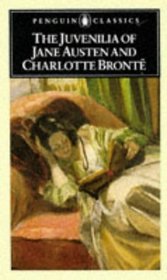Janice A. (prncessjs) reviewed The Juvenilia of Jane Austen and Charlotte Bronte (Penguin Classics) on + 79 more book reviews
From the back of the book:
In many ways Jane Austen and Charlotte Bronte were radical opposites. Jane Austen epitomizes neoclassical elegance and proportion, Charlotte Bronte the sensibility of the romantic spirit.
Their most striking similarity was that both produced a considerable body of juvenilia. For both authors this was a period in which to experiment and to develop character and style. Their work moved in very different directions: in her first short burlesque, Jane Austen exhibits a merciless wit as she lampoons human vanitites and vices, later sharpened in 'The Three Sisters' and 'Catherine' to reveal a maturer moral perspective. Charlotte Brontes appetite was for romantic adventure and, with her brother Branwell, she created the fabulous kingdom of Angria. Yet the prevailing interests of her novels - a concern with the psychological intricacies of her characters relationships and a desire to explore the forms of human passion - are already apparent. As Frances Beer comments in her introduction, both sets of juvenilia provide us with an extraordinary opportunity to watch the growth and coalescence of the creative consciousness.
In many ways Jane Austen and Charlotte Bronte were radical opposites. Jane Austen epitomizes neoclassical elegance and proportion, Charlotte Bronte the sensibility of the romantic spirit.
Their most striking similarity was that both produced a considerable body of juvenilia. For both authors this was a period in which to experiment and to develop character and style. Their work moved in very different directions: in her first short burlesque, Jane Austen exhibits a merciless wit as she lampoons human vanitites and vices, later sharpened in 'The Three Sisters' and 'Catherine' to reveal a maturer moral perspective. Charlotte Brontes appetite was for romantic adventure and, with her brother Branwell, she created the fabulous kingdom of Angria. Yet the prevailing interests of her novels - a concern with the psychological intricacies of her characters relationships and a desire to explore the forms of human passion - are already apparent. As Frances Beer comments in her introduction, both sets of juvenilia provide us with an extraordinary opportunity to watch the growth and coalescence of the creative consciousness.




